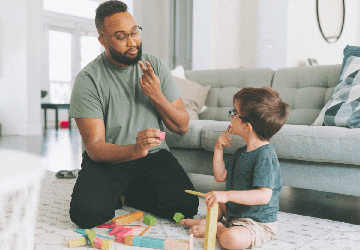Healthy communication between mother and child is essential to maintaining a solid bond and supporting the baby's development. Although babies may not express themselves verbally, communication occurs through cues, gestures, and interactions. Here are key strategies for promoting healthy communication between mother and baby:

1. Responsive Parenting:
Responsive parenting is about paying close attention to and responding to your baby's signals. Moms can recognize hunger, tiredness, discomfort, and other needs by paying close attention to their baby's facial expressions, movements, and sounds. Quick and responsive answers lay the foundation for trust and security.
2. Eye Contact and Facial Expressions:
Babies respond very well to facial expressions and eye contact. Moms can engage their babies by making eye contact, smiling, and using expressive facial expressions; this creates a non-verbal connection that makes them feel seen and understood.
3. Infant Directed Speech (Ids):
Young children are attracted to a particular type of language called child-directed or "mother tongue." It includes speaking in a higher pitch, using exaggerated intonation, and emphasizing facial expressions. The rhythmic and melodic quality of IDS engages young children and promotes communication.
4. Touch and Physical Contact:
Physical touch is a powerful form of communication. Mothers can convey love, comfort, and security through gentle touch, hugs, and skin-to-skin contact. Physical intimacy also modulates the baby's physiological responses and promotes a sense of security.
5. Interactive Games:
Incorporate interactive games into daily life. Simple games like peek-a-boo or a gentle tickle can encourage communication through laughter, smiles and shared fun. Interactive play supports the development of social and emotional bonds.
6. Read Aloud:
By reading aloud, young children learn the rhythm and rhythm of language. Choose age-appropriate books with bright colours and simple illustrations. Reading promotes bonding and familiarizes your baby with the nuances of language.
7. Establish a Routine:
Young children thrive on routine and predictability. Establishing consistent feeding, diapering, and sleeping routines creates a structured environment. Predictable routines make young children feel safe and allow them to anticipate and participate in daily activities.
8. Sign Language Communication:
By learning basic sign language gestures like "more," "eat," or "sleep," young children can express their needs before they can speak; this improves early communication skills and reduces frustration.

9. Reaction to Sounds:
Encourage vocalizations by responding to the baby's coos, babbles, and other vocal expressions. Mimicking sounds and participating in "conversations" promotes a sense of back-and-forth communication, laying the foundation for language development.
10. Create a Safe Exploration Environment:
Provide a safe and stimulating environment that encourages exploration. Young children learn through sensory experiences, and rich environments with age-appropriate toys, textures and sounds support cognitive and motor development while encouraging communication.
11. Pay Attention to Nonverbal Cues:
Babies communicate through non-verbal signals such as body language and facial expressions. Mothers can develop a keen awareness of these signals, allowing them to respond appropriately to their baby's emotional and physical needs.
12. Keep a Calm and Positive Attitude:
Infants are sensitive to the emotional tone of their caregivers. Maintaining a calm and positive attitude creates a nurturing environment that promotes healthy communication. In a positive atmosphere, young children are likelier to feel safe and willing to interact.
13. Patience and Observation:
Developing healthy communication takes time. Mothers should be patient and let their babies express their thoughts. Observing and interpreting your baby's signals without rushing can make communication more natural and authentic.
Conclusion
Promoting healthy communication between mother and baby is a dynamic and reciprocal process. Mothers can lay the foundation for a solid and lasting bond with their infants through responsible parenting, using all forms of nonverbal communication, and creating a supportive environment for exploration and interaction. These early communication experiences are critical for the baby's health and help develop essential social and cognitive skills.



